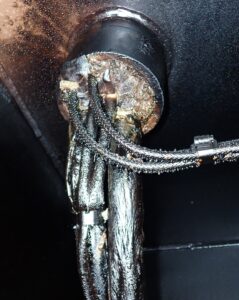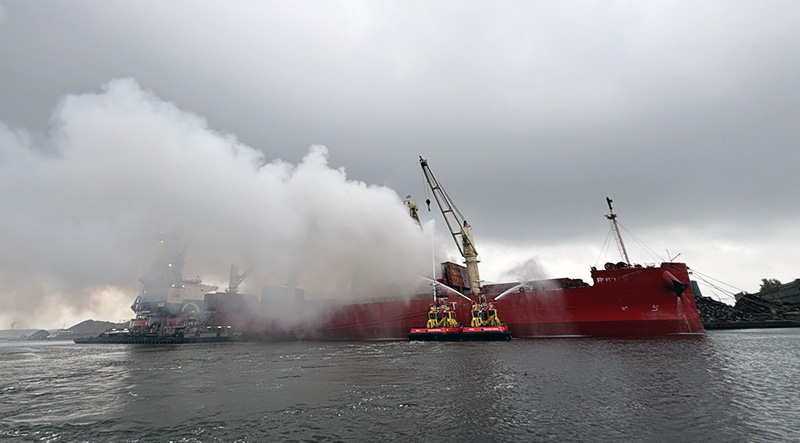In recent months NNPC Correspondents has assisted with a number of incidents involving cargoes of iron scrap igniting during loading or while already on board. Each incident posed significant risks to crew, safety, ship integrity, cargo value and the environment, often resulting in considerable costs. Authorities may impose fines or seek exercise recourse for expense incurred (e.g. as firefighting costs) or restrict the removal of cargo residues or firefighting water remaining in the vessel’s hold, often classifying such residues as waste due to their oily and contaminated nature.
As the maritime industry increasingly ships scrap metals—including both ferrous and non-ferrous materials—for recycling and export, fire incidents caused by improperly handled or contaminated scrap are becoming more frequent. This article examines the main causes of scrap fires on ships and outlines key mitigation strategies that shipping companies, port authorities, and regulators can implement to prevent such incidents.
Understanding the Risk: What Causes Scrap Fires?
Scrap cargo often contains a mix of metal waste, sometimes contaminated with flammable materials such as oil residues, plastics, batteries, or pressurized containers.
The man causes of fires include:
- Chemical Reactions: certain metals (e.g., aluminum, magnesium) can react exothermically when exposed to moisture or oxygen.
- Self-Heating: grease, oil, or other combustible contaminants can undergo spontaneous combustion in certain conditions.
- Spark Ignition: sparks from welding, grinding, or even friction during loading and unloading can ignite flammable elements.
- Undeclared Hazardous Items: hidden ignition sources, such as lithium batteries or pressurized gas cylinders, may be present if cargo is improperly screened.

Mitigation Strategies: How can the risk be prevented?
- Pre-Shipment Inspection and Certification
- Thorough Pre-Loading Inspections: Cargo should be visually inspected and sampled before loading to identify and remove potentially hazardous items. While vessel crews may observe the cargo during loading, this often provides limited visibility. Ideally, inspection occurs on the quay or in storage prior to loading. A pre-loading inspection by a surveyor is advisable if there is any doubt.
- Cargo Certification: Shippers should certify that scrap cargo is free from combustible contaminants and hazardous materials, in compliance with the IMSBC Code. When this is not possible, shippers must provide a formal cargo declaration detailing moisture content, chemical properties, and other relevant characteristics, including the cargo’s IMSBC group (A, B, or C).
- Proper Cargo Handling and Segregation
- Mechanical Sorting and Cleaning: Scrap should be cleaned and sorted onshore to remove contaminants such as oil, rubber, plastics, and batteries. Batteries or electrical equipment combined with oily or combustible materials present an increased ignition risk during loading. We have seen that during loading operations the combination of these materials may cause ignition when exposed to friction during load operations. As indicated above it will often be difficult to perform such sorting and cleaning while loading operations are underway – hence the importance of verifying the condition of the cargo already prior that stage.
- Documentation: If certain high-risk items such as electronics, batteries, aluminum or other reactive metals are present, they must be separated and documented.
- Temperature Monitoring
- Thermal Imaging and Sensors: Use temperature sensors or infrared scanners during loading and transit to detect hotspots in cargo holds.
- Routine Inspections: Crew should monitor cargo temperatures and ventilation systems, especially during the first 48 hours after loading.
- Fire Detection and Suppression Systems
- Fixed Fire Suppression Systems: CO2 flooding systems or water mist systems in cargo holds may help extinguish fires without the need for crew exposure.
- Portable Equipment: Fire extinguishers rated for Class A, B, and D fires (especially for metal fires) should be available in cargo areas.
- Remote Monitoring: Smart ship systems can alert the crew in real-time to changes in temperature, gas composition, or smoke.
- Crew Training and Emergency Preparedness
- Firefighting Drills: Conduct regular drills tailored to scrap cargo fire scenarios. Incident investigations frequently highlight inadequate cargo screening, poor documentation, and insufficient crew awareness.
- Cargo-Specific Training: Crew must understand the hazards associated with the cargo on board and the correct extinguishing methods (e.g., not using water on burning magnesium).
- Regulatory Compliance and Best Practices
- Adherence to IMSBC Code: Follow guidance for the safe carriage of solid bulk cargoes, including scrap metals.
- Flag and Port State Control: egular audits and inspections ensure compliance and operational readiness.
- Documentation: Cargo declarations and hazard assessments must be precise. Failure to disclose hazardous contents can result in penalties or detention.
 Recent incidents have driven the industry to strengthen fire detection and prevention measures. Investigations frequently reveal that inadequate segregation or undisclosed hazardous materials were the root cause. These findings highlight the importance of close collaboration between shippers, port operators, and vessel operators. Ensuring local presence during loading, attending pre-loading operations, and carefully verifying cargo documentation beforehand can significantly reduce the risk of such incidents.
Recent incidents have driven the industry to strengthen fire detection and prevention measures. Investigations frequently reveal that inadequate segregation or undisclosed hazardous materials were the root cause. These findings highlight the importance of close collaboration between shippers, port operators, and vessel operators. Ensuring local presence during loading, attending pre-loading operations, and carefully verifying cargo documentation beforehand can significantly reduce the risk of such incidents.
In this regard, NNPC Correspondents BV and our network remain available at correspondents@nnpc-correspondents.nl to provide advice and, where required, local assistance with preventive or mitigating measures.

